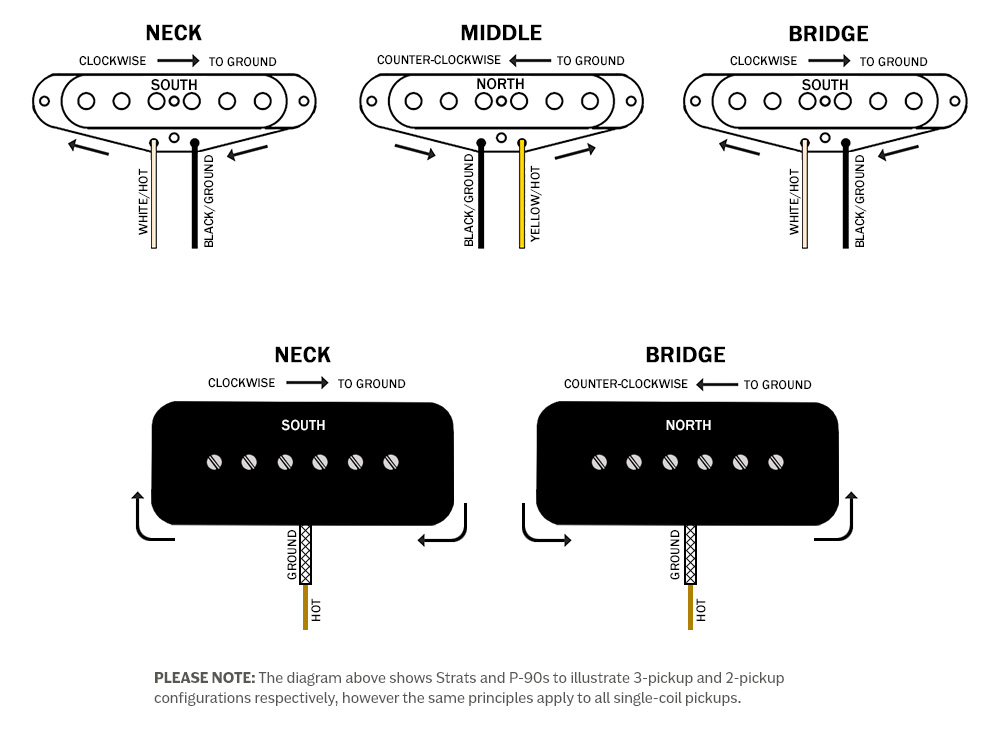Pickup Phase
What Is It And Why Is It Relevant?
A pickup’s phase refers to whether the signal’s waveform starts as either positive or negative. This is the result of the interaction of two things: the signal flow around the coil (clockwise or counterclockwise) and which end of the magnets face up toward the strings (North or South polarity facing up).
Stock Lollars are built either South Up/Clockwise to ground, or North Up/Counter-clockwise to ground and are in what we describe as negative phase. The opposite configurations (South Up/Counter-clockwise and North Up/Clockwise) would both create positive phase.

Understanding the relationship between pickup phase and the sound you hear from your instrument can help you troubleshoot issues and help avoid frustration. An individual pickup has its own phase, so therefore when combining any two pickups, issues can arise if the phase of each pickup does not match – if the phase of Pickup A is negative and that of Pickup B is positive, for example.
In-phase and Out-of-phase
Pickups that are all negative phase or all positive phase are described as in-phase, whereas sets that have pickups in both negative and positive phase are described as out-of-phase.
Out-of-phase pickups have signals that cancel out much of the frequency content when both pickups are on at the same time. The resulting frequency cancelation results in a noticeable reduction in low- and mid-range frequencies.

Troubleshooting Out-of-phase Pickups
All stock Lollar pickups are in-phase with each other, unless ordered to custom specifications. So, if you experience the thin, brittle sound in the middle/combined position after installing a set of Lollars, it’s likely that the pickup’s lead wires were installed backwards: the hot lead going where the ground lead should be, and ground going where the hot lead should. The fix is as easy as reversing them, so that hot goes to hot, and ground goes to ground.
Pickups can also often be out-of-phase when combining pickups from two different manufacturers. There is no “standard” phase between different builders. If you’re installing a Lollar along with a pickup of another brand, there’s a chance they won’t be in-phase even if you install them correctly because of the way they’re built.
The same fix of reversing the leads can apply but not always: it depends on what type of leads the pickups have and whether or not the magnets or pole pieces are insulated from the coil. Reversing the leads reverses the flow of the signal around the pickup coil, which in turn flips the pickup phase. But not all pickup types have leads that can be flipped.
It’s worth noting that, in a guitar that has two pickups wired in parallel, with each pickup having its own volume control, it is normal to notice a small reduction in volume when both pickups are engaged and both volume controls are turned all the way up. However, if the two pickups are out of phase, this drop in volume will be considerably greater and, if you roll down one of the volume controls, you’ll actually notice an increase in overall volume.
Flipping Phase On Fender-style Pickups
In pickups with pushback leads (like Strats and Jazzmasters) and insulated magnets, phase can be flipped by switching the hot and ground in your wiring. Note: for reasons too detailed to cover here, we don’t recommend flipping the leads on Fender brand pickups. Telecaster pickups require an additional 3rd wire to flip the phase. This is necessary because the Tele ground wire is connected to the pickup’s metal baseplate (bridge) or cover (neck). You can’t reverse Tele leads with only two leads, because doing so would make the cover and baseplate lead (typically ground) into the hot lead. This turns the covers/baseplates (therefore your pickups) hot themselves, making them unusably noisy.
Flipping Phase Of Gibson-style Pickups
With the traditional single-conductor Gibson-style lead, hot and ground are on the same wire: the metal exterior is ground, and the interior wire is hot – so you can’t flip that as you would with a Fender-style pair of leads. Humbuckers with 4-conductor leads allow you to flip the separate hot and ground wires, just as Fender-style leads would. Same goes for P-90s: the vintage style single-conductors can’t be flipped, but if you have an additional lead (an option that many builders offer, including Lollar) you can flip hot and ground to reverse phase.
How Can I Avoid Phase Issues If I Don’t Know My Pickup’s Phase?
It’s always worth reaching out to manufacturers to ask about coil wind, signal flow direction and magnetic polarity. If you contact us with that information, we’ll immediately be able to tell you if our pickups are compatible or not. If they’re out-of-phase, we can build you a custom pickup to match in most cases.
If you can’t reach the builder or want to find out on your own, the video below shows how you can perform a simple phase test with a piece of ferrous (magnetically conductive) metal and a multimeter.
And of course, if you have any questions about function, phase, compatibility, or pickups in general, you can always reach out to us directly at (206) 463 9838 or via email at [email protected]—we’re here to help!